6 Symptoms of a Bad Catalytic Converter (and Replacement Cost)
Catalytic converters (not cadillac converters as some like to say) help remove carbon monoxide (and other toxic gasses) that a car produces from entering the outside air that we breathe. While it’s likely you will never need to repair or replace yours, sometimes they fail.
Keep reading to learn the symptoms of catalytic converter failure, what causes it, and how much it will cost to replace it.
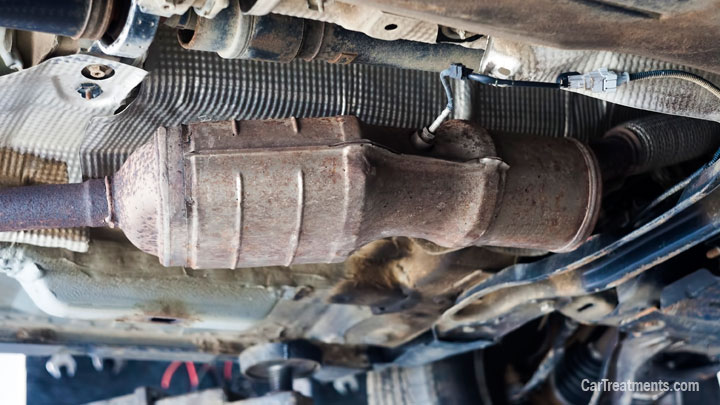
Bad Catalytic Converter Symptoms
Here are 6 common symptoms letting you know your catalytic converter is clogged or bad.
#1 – Rotten Egg Smell From Exhaust

If you smell something that seems like rotten eggs, it’s a tell tale sign of a failed catalytic converter. Gasoline contains a small amount of sulfur which converts to hydrogen sulfide during the combustion process.
A catalytic converter that’s working like it’s supposed to, converts the smelly sulfide into odorless sulfur dioxide. When the cat is bad, the conversion doesn’t take place so some of the unburnt gases containing the smelly hydrogen sulfide exit your exhaust.
#2 – “Check Engine Light” is On

If your vehicle’s catalytic converter is failing or has gone bad, the “Check Engine Light” will illuminate on the dashboard. Modern vehicles contain oxygen sensors which are able to monitor the catalytic converter’s efficiency by checking the exhaust’s gas levels.
If these sensors detect the exhaust gases are not being catalyzed properly for whatever reason, the “Check Engine Light” will come on. The driver will then know something is wrong, although they won’t know exactly what the problem is because the light can mean a lot of different things.
The best thing to do is retrieve the trouble codes from the car using a diagnostic scan tool. P0420 and P0430 are two common fault codes that indicate a catalytic converter failure.
#3 – Poor Acceleration

One of the most common symptoms of a clogged catalytic converter is a lack of power from the engine, particularly when you try to accelerate such as when you need to pass another vehicle quickly.
When carbon buildup within the honeycomb design gets to be too much or when the internals start to melt due to excess heat from unburned fuel, a partial blockage inside the catalytic converter takes place.
Your engine depends on good exhaust flow to operate at peak power. When the flow is restricted due to a clogged converter, you’ll notice a lack of power when accelerating, going up a hill, or towing a heavy load.
For cases of clogging due to carbon buildup, cleaning your catalytic converter can help remove the blockage.
#4 – Failed Emissions Test
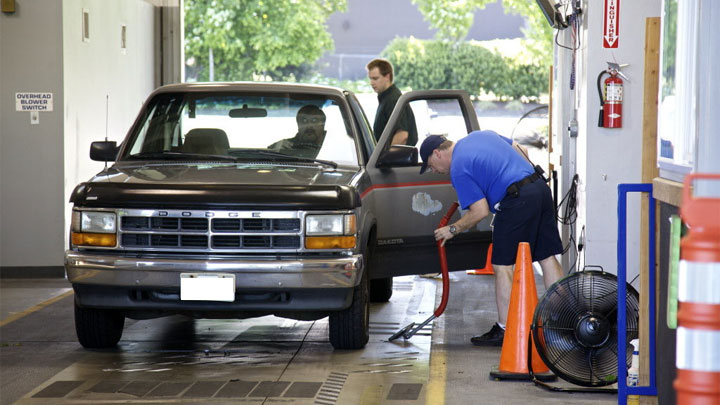
Most parts of the Unites States require your vehicle to pass a smog test every few years to make sure your car is properly burning fuel and not expelling dangerous gases into the atmosphere. One of the most common reasons for failing a smog test is a bad catalytic converter.
Depending on your vehicle, diagnostics will be done through either the OBD2 port on your car (cars made in 1996 or newer) or with a hose connected to the end of your tailpipe that directly measures levels of toxic gases (cars made before 1996).
#5 – Rattling Noise
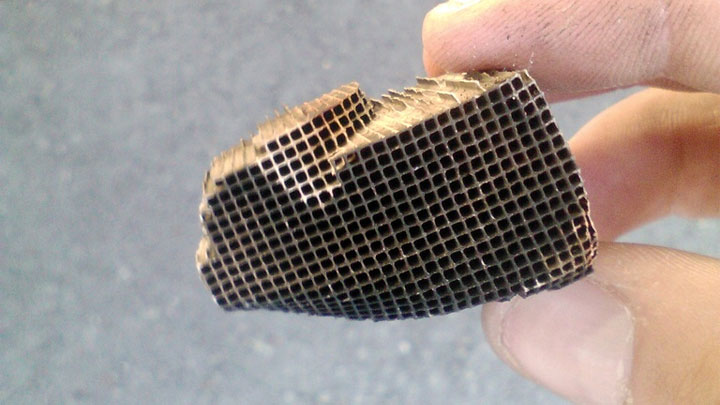
If parts of the honeycomb material inside the catalytic converter break apart due to excessive heat or damage, you will likely notice a rattling sound coming from under your vehicle while idling or driving. The noise will often be the loudest when starting the car.
You’ll want to replace the cat as soon as possible as those chunks of dislodged material can actually make their way further down the exhaust system and into the muffler. This blockage can then cause the car to stall and even prevent you from starting your car back up.
Read Also: 5 Ways to Remove a Stripped, Rounded Off, or Rusted Bolt
#6 – Reduced Fuel Economy
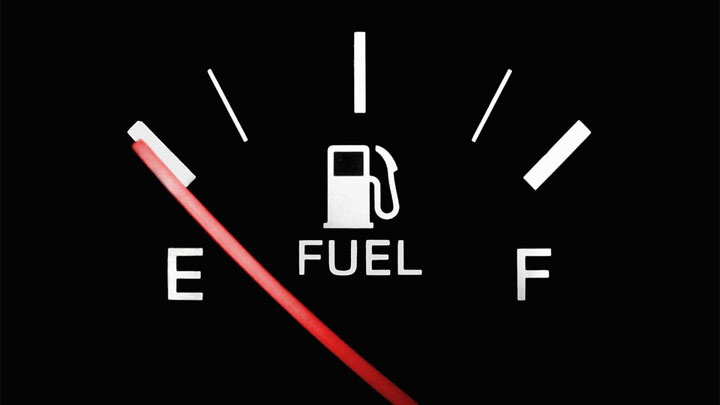
When you have a blockage in your catalytic converter, the lower airflow can cause your car to burn more fuel than it needs. Related to the poor acceleration symptom above, when you don’t have proper exhaust flow, you are forced to step on the gas pedal more since acceleration is affected.
That correlates to the engine injecting more fuel into the cylinders which causes the car to have a much richer fuel mixture than needed.
Since a decrease in your gas mileage is a symptom of many other issues, it alone doesn’t mean you need to replace your catalytic converter. But combined with one of the signs above, it may be a good indicator.
Catalytic Converter Replacement Cost
Best places to order parts? See: 19 Best Online Auto Parts Stores
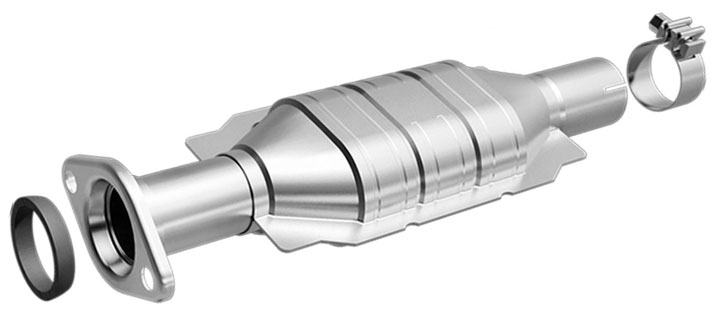
Because of the precious metals used in its construction (ie: platinum and palladium), replacing a catalytic converter is not cheap. Things to keep in mind are the age and make of the vehicle, number of catalytic converters on the car, and whether the cat is an OEM or aftermarket part.
Gasoline Engines – 1981 and Newer
Almost all gasoline engine cars build since 1981 have a three-way catalytic converter. This design is more complicated than those in older cars which means the parts cost is also high.
On average, expect to pay anywhere between $500 and $2,200 to replace a catalytic converter in newer cars. Parts alone will cost $400 to $2,000. Labor costs will set you back $75 to $150 for the estimated one hour of labor needed for replacement.
Gasoline Engines – Before 1981 (and Diesel Engines)
Gasoline engine cars built before 1981 and most diesel engines (any year) have two-way catalytic converters. Since the design is fairly simple, replacement costs are usually cheaper.
Total cost of a catalytic converter replacement in these older cars will run you about $175 to $750. You’ll be paying about $100 to $600 in parts and another $75 to $150 in labor. Keep in mind that the older or rarer a vehicle is, the more expensive a replacement cat due to scarcity.
Can You Repair a Catalytic Converter?
It depends. If you believe you simply have a dirty or clogged catalytic converter, adding some type of catalytic converter cleaner to your gas may help clear up the clog. It may take more than one use.
An alternative and much strong method of cleaning a catalytic converter is to remove the cat and soak it in a solution of citric acid for 6-8 hours.
Another option is using sodium hydroxide. Here’s a good video explaining the process:
If there is damage to the catalytic converter including pieces of the honeycomb breaking off inside, it’s simply not fee-sable to attempt any type of catalytic converter repair (even though you’ll find people online saying otherwise). In these cases, replacement is really your only option.
What is a Catalytic Converter?
A catalytic converter, also commonly referred to as a “cat”, is part of the exhaust system. It’s positioned between the exhaust manifold and the resonator or muffler.
Most cars on the road today have one catalytic converter but many with dual exhausts have two (one unit for each set of pipes). Some higher end vehicles now have two cats in-line which further reduces harmful emissions gases.
Its job is to filter out or “convert” the harmful gases (nitric oxide, carbon monoxide, and unburned hydrocarbons) a vehicle produces before they enter the atmosphere. These toxic gases almost single handedly ended the classic muscle car era in the 70’s and are responsible for much of the smog found in large cities.
See Also: What is a CAT-Delete?
How Does a Catalytic Converter Work?
After a vehicle is started up, the toxic gases produced by the car’s engine pass through a catalytic converter. The internal structure of the cat consists of a honeycomb design made up of precious metals such as platinum, palladium, and rhodium.
At a high temperature that a catalytic converter is designed to function at (about 800 degrees F), a chemical reaction occurs where the end result are safer elements that come out of your muffler such as oxygen, water, and carbon dioxide.
What Causes a Catalytic Converter to Go Bad?
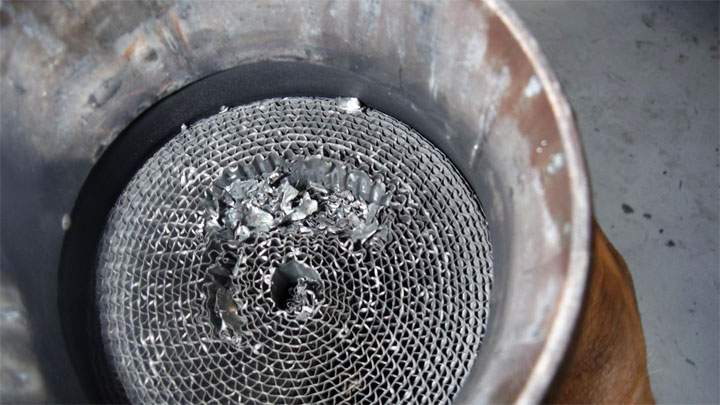
As mentioned earlier, most catalytic converters will last the lifetime of a vehicle. But in some cases, a cat will go bad and need to be replaced.
Almost all problems with a catalytic converter are because of an engine issue. It is most often caused by excess fuel entering the exhaust system due to an incorrect air/fuel mixture, bad spark plugs, incorrect engine timing, failed oxygen sensor, or other issues where fuel leaves the engine’s combustion chamber unburned.
When this happens, the catalytic converter reaches a temperature that’s too high and actually begins to melt the internals of the cat or break apart the honeycomb material. The result is a non-functioning cat.
In addition, failed gaskets, bad valve seals, or worn piston rings can cause oil or antifreeze to enter the exhaust system and coat the ceramic catalyst within the converter with a thick carbon soot.
If this is allowed to go on long enough, these carbon deposits will clog the catalytic converter so it can’t do its job. Worst case, exhaust flow is completely blocked and backpressure builds back up to the engine which can cause overheating and other problems.
Finally, physical damage to the cat can occur. Though not common, rocks, road debris, or potholes can all damage or crack the outside shell of a cat or the hangers that support it.
A dented catalytic converter often means that parts of the fragile ceramic catalyst have broken off inside and functionality of the cat is reduced.
How to Help Prevent Clogging
If you regularly drive short distances with your car, the hydrocarbons may not be getting burnt away completely because the catalytic converter is not getting the opportunity to get hot enough. To reduce your chances of having a clogged catalytic converter, try driving your vehicle on the highway every now and then for around 10 to 15 minutes.
This will create the necessary heat inside the cat to effectively burn off these hydrocarbon deposits so your cat is running as efficiently as possible.
Regular use of an exhaust system cleaner like Cataclean will also help prevent clogging.
- Replace the Engine or Replace the Car? (11 Factors to Consider) - Apr 11, 2024
- Plastic Piece Dragging Under Your Car? (What It Is and What To Do) - Mar 21, 2024
- Timing Belt vs Timing Chain (What’s the Difference?) - Feb 27, 2024
